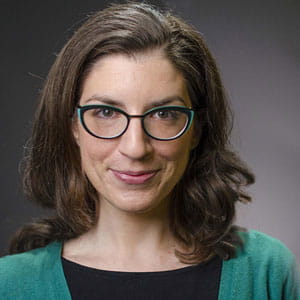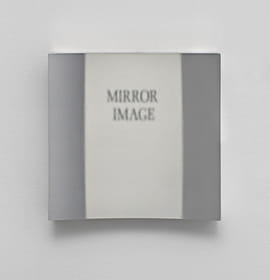NYC Art Gallery Displays Non-Reversing Mirror Invented by Drexel Math Professor
 By Rachel Ewing
By Rachel Ewing

- Drexel Selects New, World-Class Life Sciences Building at 3201 Cuthbert Street for Medical Research Operations
- Breakthrough on Gene Therapy for Hereditary Spastic Paraplegia
- Drexel Environmental Collaboratory Releases Cross-Sector Findings on Severe Weather Recovery Challenges
- Student Sketches Bring Drexel’s Historic Objects to Life

When you look in a mirror, you see an image of yourself in reverse. But one odd mirror invented by mathematics professor Dr. R. Andrew Hicks at Drexel University shows your true face without reversing its image. That mirror is now on display as part of an art exhibition in New York City’s Room East gallery by artist Robin Cameron, through December 9.
Hicks’s unusual mirrors gained national attention in summer of 2012 when one of those inventions, a driver’s side mirror that eliminates the blind spot with minimal distortion, received a U.S. Patent.
Other novelty mirrors show a non-reversed image to a viewer by placing two mirrors at right angles, so that looking at the glass shows a simple reflection of the reflection. Hicks’s non-reversing mirror is different, in that it is a single, smooth curved piece of glass that shows a non-reversed image.
Cameron found inspiration in Hicks’s story when she discovered it through online research. Hicks and Drexel subsequently loaned her the non-reversing mirror for use in her group of artworks entitled “P-R-O-C-E-S-S-E-S.”
“The mirror specifically relates to this particular grouping of work because it is about process. I wanted to know more about what leads someone to make a non-reversing mirror,” Cameron said.
“The mirror specifically relates to this particular grouping of work because it is about process. I wanted to know more about what leads someone to make a non-reversing mirror,” Cameron said.
“I see some similarities to the work that I do and the work that Andrew does, in terms of following what interests you and creating something new.” Cameron said.
Beyond its value as an object of art, Hicks considers the non-reversing mirror an interesting novelty and is still looking for practical applications. “I always thought it would make a great toy,” Hicks said.
The mirror is popular when he shows it at talks and in classes. “People often think that such a thing should be impossible, and they want to hold it and look at it from different angles,” he said. “It's sort of as if some object from an M.C. Escher print existed in the real world.”
Note to news media: Additional photos are available to download here. For gallery photos, please credit ROOM EAST, New York.
In This Article
Contact
Drexel News is produced by
University Marketing and Communications.